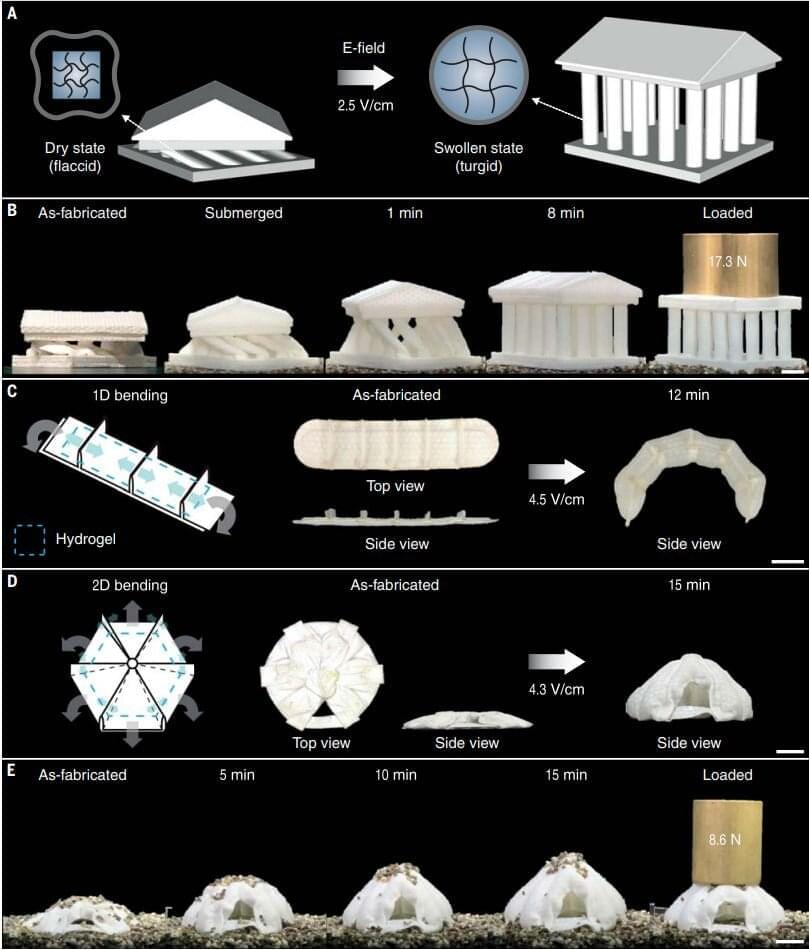The failures of One Laptop per Child have much to teach us about fixing educational inequities.
Get the latest international news and world events from around the world.

Combining turgor design and electro-osmosis to create strong and fast hydrogel actuators
A team of researchers at Seoul National University has created a stronger and faster hydrogel actuator by combining turgor design and electro-osmosis. In their paper published in the journal Science, the group describes their approach and how well the resulting actuator performed when tested in a real-world experiment. Zhen Jiang and Pingan Song, with the University of Southern Queensland, outline some of the difficulties researchers have faced in trying to create hydrogels that imitate biological organisms and comment on the work done by the team in Korea in a Perspective article published in the same journal issue.
Hydrogels, as their name suggests, are gels made with a water base. Roboticists have been studying them closely for several years. The goal is to create soft actuators, which are deformable components that are able to interact with the environment in desired ways. To succeed, the actuator needs to be able to convert some form of energy into mechanical work, similar in some sense to human muscles. To make them more useful, scientists would like them to have stronger actuation forces than are now possible and to respond faster when the need arises. In this new effort, the researchers have taken another step toward achieving both goals.
The team created a hydrogel using standard techniques but enclosed it in a highly osmotic and stiff wrapping. The stiffness was designed to contain a swelling environment as a liquid made its way into the turgor cell-like construction. This allowed pressure to build up, and as it did so, it exerted a force against nearby objects. Testing of the cell showed it created enough force (730 N) to split a common building brick. The researchers note that such force was approximately 1,000 times greater than any other known hydrogel. And to speed up the action, the researchers applied an electric current, which drove the actuation speed to 19 times that of its normal osmotic rate.


A Decade of Science and Trillions of Collisions Show the W Boson Is More Massive Than Expected — A Physicist Explains What It Means
“You can do it quickly, you can do it cheaply, or you can do it right. We did it right.” These were some of David Toback opening remarks when the leader of Fermilab’s Collider Detector unveiled the results of a decade-long experiment to measure the mass of a particle known as the W boson.
I am a high energy particle physicist, and I am part of the team of hundreds of scientists that built and ran the Collider Detector at Fermilab in Illinois – known as CDF.
After trillions of collisions and years of data collection and number crunching, the CDF team found that the W boson has slightly more mass than expected. Though the discrepancy is tiny, the results, described in a paper published in the journal Science on April 7, 2022, have electrified the particle physics world. If the measurement is indeed correct, it is yet another strong signal that there are missing pieces to the physics puzzle of how the universe works.
Hackers say cracking power grid tech was easiest challenge yet
During an industrial control systems hacking challenge, a Dutch team won $40,000 for cracking tech used to control the power grid.


Chapter Seven — 2021 Dr. Burzynski — Artificial Intelligence & the Extinction of 99% of Oncologists
A series of interviews recorded in August of 2021 with Dr. Stanislaw Burzynski.
Watch 2016 Movie: https://www.youtube.com/watch?v=F_7LZ8GLerI
Full Channel: https://www.youtube.com/channel/UCLiRbQrj-gBow6VdLajWxaw.
https://www.burzynskimovie.com/
Notes from Dr. Burzynski:
1. Cancer is the disease of information processing which I described in the article in.
1986.
2. This “computer software ” consists of the network of mutated genes and in most.
patients these genes are not inherited as mutated. The mutations occur during.
patient’s life. The ” software” instructs the body to make billions of malignant cells.
3. This software should be removed from patient’s body. As long as it stays in the.
body the cancer will come back.
4. This is the reason why standard of care can’t cure advanced cancer with surgery.
radiation and chemotherapy, while they decrease tumor size they can’t remove mutated genes.
5. Antineoplastons have a chance to do it because based on laboratory studies they.


Why Venus Rotates, Slowly, Despite Sun’s Powerful Gravitational Pull
Gaining clarity about the factors that contributed to a runaway greenhouse state on Venus, Earth’s closest planetary neighbor, can also help improve models of what could one day happen to Earth’s climate.
“Ultimately, my motivation in studying Venus is to better understand the Earth,” Kane said.
Reference: “Atmospheric dynamics of a near tidally locked Earth-sized planet” by Stephen R. Kane, 22 April 2022, Nature Astronomy.